Introduction to laser safety goggles
This page gives information on how to determine the minimal required rating for laser safety goggles according to the European norm EN 207. An online calculator following the prescriptions of the norm is available here.
Warning
Laser safety goggles are the last step of laser safety precautions and are not a substitute for learning and applying laser safety rules.
The EN 207 norm
In Europe, the norm that specifies requirements for laser safety goggles is the EN 207. Certified goggles are marked with the CE logo; they can sustain their nominal optical depth for at least 5 seconds of direct exposure to a CW laser, or 50 pulses of a pulsed laser.
The EN 207 uses a simplified model to determine the required optical density for a given beam wavelength and intensity, derived from the IEC 60825-14 norm. The IEC 60825-14 defines the Maximum Permissible Exposure (MPE) and explains how to calculate it for a given laser.
Compared to the model used by the IEC, the simplified model used by the EN 207 leads to stricter requirements for the the optical attenuation needed, and is the only norm that should be used to determine the minimal required rating for laser safety goggles.
Beam diameter
In the case of a naked eye exposed to visible laser light, a collimated beam (up to a diameter of 7 mm) is more dangerous than a focused beam, because the eye will focus the light down to a 0.01 mm spot on the retina. However, a focused laser beam will cause more damage to a goggle than a larger beam of the same power. This is why, when choosing laser safety goggles, one should consider the minimum laser beam diameter that could hit the goggles under reasonably foreseeable circumstances.
The EN 207 certifies goggles for a laser beam power density (power per unit area), or pulse energy density for pulsed lasers. To calculate these quantities, one needs the power (or pulse energy) of the laser and the minimum beam diameter d. This diameter is the 1/e beam diameter, meaning that at least 63 % of the laser power must fit in a circle of diameter d. This diameter should be the minimum laser beam diameter that could hit the goggles under reasonably foreseeable circumstances.
EN 207 ratings for laser safety goggles
To calculate the minimal EN 207 rating ("scale number") for your laser safety goggles, refer to the following tables:
Table 1 — Laser types D, I, R, M:
| Symbol | Laser type | Typical pulse duration |
|---|---|---|
| D | Continuous wave (CW) laser | > 0.2 s |
| I | Pulsed laser | 10-6 s to 0.2 s |
| R | Giant-pulsed laser | 10-9 s to 10-6 s |
| M | Mode-coupled laser | < 10-9 s |
Table 2 — EN 207 scale numbers:
| Scale number | OD | Maximum power density (E) and energy density (H) | ||||||||
|---|---|---|---|---|---|---|---|---|---|---|
| 180 nm to 315 nm | 315 nm to 1400 nm | 1400 nm to 1000 μm | ||||||||
| Laser type | ||||||||||
| D | I, R | M | D | I, R | M | D | I, R | M | ||
E | H | E (W/m2) | E (W/m2) | H (J/m2) | E (W/m2) | E (W/m2) | H (J/m2) | E (W/m2) | ||
| LB1 | 1 | 0.01 | 3×102 | 3×1011 | 102 | 0.05 | 1.5×107 | 104 | 103 | 1012 |
| LB2 | 2 | 0.1 | 3×103 | 3×1012 | 103 | 0.5 | 1.5×108 | 105 | 104 | 1013 |
| LB3 | 3 | 1 | 3×104 | 3×1013 | 104 | 5 | 1.5×109 | 106 | 105 | 1014 |
| LB4 | 4 | 10 | 3×105 | 3×1014 | 105 | 50 | 1.5×1010 | 107 | 106 | 1015 |
| LB5 | 5 | 102 | 3×106 | 3×1015 | 106 | 5×102 | 1.5×1010 | 108 | 107 | 1016 |
| LB6 | 6 | 103 | 3×107 | 3×1016 | 107 | 5×103 | 1.5×1011 | 109 | 108 | 1017 |
| LB7 | 7 | 104 | 3×108 | 3×1017 | 108 | 5×104 | 1.5×1012 | 1010 | 109 | 1018 |
| LB8 | 8 | 105 | 3×109 | 3×1018 | 109 | 5×105 | 1.5×1013 | 1011 | 1010 | 1019 |
| LB9 | 9 | 106 | 3×1010 | 3×1019 | 1010 | 5×106 | 1.5×1014 | 1012 | 1011 | 1020 |
| LB10 | 10 | 107 | 3×1011 | 3×1020 | 1011 | 5×107 | 1.5×1015 | 1013 | 1012 | 1021 |
To use these tables, first find the correct laser type designation (D, I, R or M) for your laser using Table 1. Then, divide the power (or energy) by the beam area and use Table 2 to find the correct scale number.
Example: a 10 mW, 632 nm CW laser with a 5 mm beam diameter. According to Table 1, the laser type is D. The power density is 10×10-3/(π×(2.5×10-3)2) = 5.1 × 102 W/m2. Thus, according to Table 2, you need D LB2 goggles.
A tool to calculate the minimal rating of laser safety goggles following the EN 207 requirements is available here.
Additional considerations
The safety glasses you must wear must have the correct EN 207 rating (both scale number and laser type). If you are working with multiple lasers at the same time, it is not enough to buy goggles with the correct EN 207 rating for each wavelength independently and you should seek advice from a laser safety officer.
Uncomfortable goggles might discourage you from wearing them so you don't hesitate to try a few different goggles. Moreover, good goggles should not prevent you from seeing so you should check the VLT of the goggles before buying them.
More information
Presentation slides of the laser safety course given by Ben Lanyon can be
Author: Réouven Assouly.

